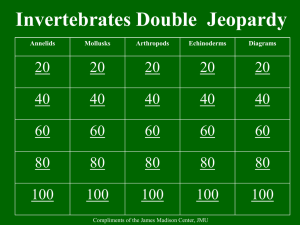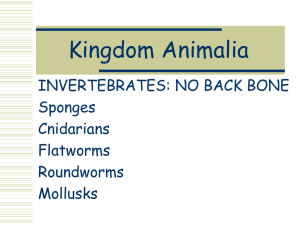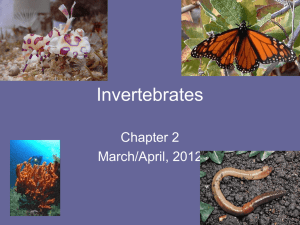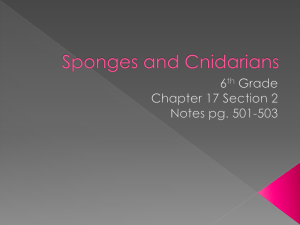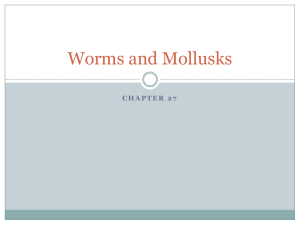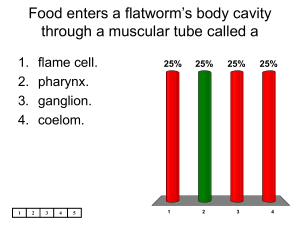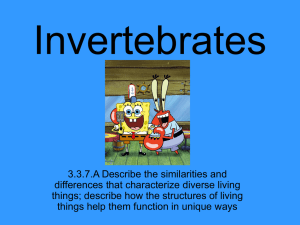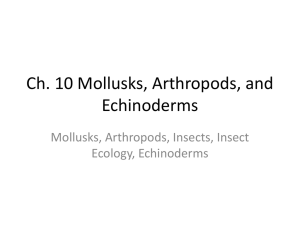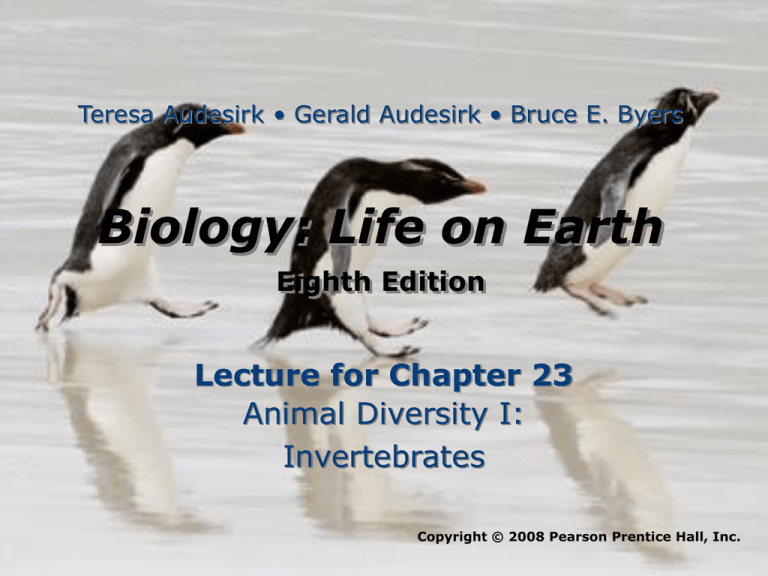
Teresa Audesirk • Gerald Audesirk • Bruce E. Byers
Biology: Life on Earth
Eighth Edition
Lecture for Chapter 23
Animal Diversity I:
Invertebrates
Copyright © 2008 Pearson Prentice Hall, Inc.
Chapter 23 Outline
• 23.1 What Are the Key Features of Animals? p.
442
• 23.2 Which Anatomical Features Mark Branch
Points on the Animal Evolutionary Tree? p. 442
• 23.3 What Are the Major Animal Phyla? p. 445
Section 23.1 Outline
• 23.1 What Are the Key Features of
Animals?
• Animals possess all of the following
characteristics
– Multicellularity
– Heterotrophic
– Most reproduce sexually
– Cells lack a cell wall
– Are motile at some point in life cycle
– Are able to respond rapidly to external stimuli
Section 23.2 Outline
• 23.2 Which Anatomical Features Mark
Branch Points on the Animal
Evolutionary Tree?
– Lack of Tissues Separates Sponges from All
Other Animals
– Animals with Tissues Exhibit Either Radial or
Bilateral Symmetry
– Most Bilateral Animals Have Body Cavities
Animal Evolution
• Most evolutionists believe animal phyla
currently populating the Earth were
present by the Cambrian period (544 million
years ago)
• The scarcity of pre-Cambrian fossils led
systematists to search for clues about the
evolutionary history of animals by
examining features of
– Anatomy
– Embryological development
– DNA sequences
Animal Evolution
• It is believed certain features represent
evolutionary milestones
– The appearance of tissues
– The appearance of body symmetry
– Protostome and deuterostome development
• These features mark major branching
points on the animal evolutionary tree
The Appearance of Tissues
• Tissues are groups of similar cells that carry
out a specific function (e.g. muscle)
• The ‘earliest’ animals had no tissues
• Sponges are the only ‘modern-day’ animals
that lack tissues
– Individual cells may be specialized, but they act
independently
• Evolutionists believe sponges & all
remaining tissue-containing phyla arose from
an ancient common ancestor without tissues
The Appearance of Body Symmetry
• Symmetrical animals have an upper
(dorsal) surface and a lower (ventral)
surface
• Animals with tissues exhibit either radial or
bilateral symmetry
Radial Symmetry
• Animals with radial symmetry can be
divided into roughly equal parts by any
plane that passes through the central axis
• Note they can be divided into more than
two parts (more than two halves)
FIGURE 23-2a
Body symmetry
and cephalization
(a) Animals with
radial symmetry
lack a welldefined head. Any
plane that passes
through the
central axis
divides the body
into mirror-image
halves.
Animals with Radial Symmetry
• Have two embryonic tissue (germ) layers
– Ectoderm (outer layer which covers the body,
lines its inner cavities, and forms the nervous
system)
– Endoderm (inner layer which lines most
hollow organs)
• Tend to be either sessile (fixed to one
spot) or drift around on currents
– e.g. cnidarians, ctenophors
Bilateral Symmetry
• Animals with bilateral symmetry can be
divided into mirror-image halves only
along one plane that runs down the
midline
FIGURE 23-2b
Body symmetry
and cephalization
(b) Animals with
bilateral symmetry
have an anterior
head end and a
posterior tail end.
The body can be
split into two
mirror-image
halves only along
a particular plane
that runs down the
midline.
Animals with Bilateral Symmetry
• Have an additional germ layer
– Mesoderm (layer sandwiched between
ectoderm and endoderm)
• Forms muscle
• Forms circulatory and skeletal systems when
present
Animals with Bilateral Symmetry
• Exhibit cephalization (the concentration of
sensory organs and a brain in a welldefined head) with definite anterior and
posterior regions
• Tend to move forward through environment
– e.g. flatworms, roundworms, arthropods,
annelids, mollusks, echinoderms, chordates
Body Cavities
• Most bilateral animals have a body cavity
• Body cavities serve a variety of functions
• Act as a skeleton (provides support for the
body and a framework against which
muscles can act)
• Form a protective buffer between internal
organs and the outside world
• Allow organs to move independently of the
body wall
Body Cavities
• Coelomate animals possess a coelom (a
fluid-filled body cavity that is completely
lined with mesoderm)
– e.g. annelids, arthropods, mollusks,
echinoderms, chordates
Body Cavities
• Pseudocoelomate animals possess a
pseudocoelom (a fluid-filled body cavity
that is not completely lined with
mesoderm)
– e.g. nematodes (roundworms)
Body Cavities
• Acoelomate animals lack a body cavity
– e.g. flatworms
Section 23.3 Outline
• 23.3 What Are the Major Animal Phyla?
– Sponges Have a Simple Body Plan
– Cnidarians Are Well-Armed Predators
– Flatworms Have Organs but Lack Respiratory
and Circulatory Systems
– Annelids Are Composed of Identical
Segments
– Most Mollusks Have Shells
– Arthropods Are the Dominant Animals on
Earth?
Section 22.3 Outline
• 23.3 What Are the Major Animal Phyla?
(continued)
– Roundworms Are Abundant and Mostly Tiny
– Echinoderms Have a Calcium Carbonate
Skeleton
– The Chordates Include the Vertebrates
Major Animal Phyla
• Animals probably originated from ancestral
colonial protists
• Present day biologists recognize about 27
phyla of animals, some of which are
summarized in Table 23-1, pp. 446-7
Invertebrates and Vertebrates
• Most animals are invertebrates (lack a
vertebral column)
• Less than 3% of all known animals are
vertebrates (possess a vertebral column)
3.2: The Sponges
•
•
•
•
Phylum Porifera
Asymmetrical body plan
Lack true tissues and organs
Body perforated by tiny pores
FIGURE 23-5
The body plan
of sponges
Water enters
through
numerous tiny
pores in the
sponge body
and exits
through oscula.
Microscopic
food particles
are filtered
from the water.
The Sponges
• Three major types of cells
– Epithelial cells (cover outer body surface)
• Some are modified into pore cells (regulate flow of
water through pores)
– Collar cells (flagellated cells that maintain
water flow through the sponge)
– Amoeboid cells (motile cells that digest and
distribute nutrients, produce reproductive
cells, and secrete spicules)
The Sponges
• Water flows through the body
– Water enters through pores and travels
through canals
• Oxygen is extracted
• Nutrients are removed and digested intracellularly
• Wastes are released
– Water exits through large openings called
oscula
The Sponges
• Internal skeleton made of spicules
– Spicules are composed of calcium carbonate,
silica, or protein
• Aquatic (mostly marine)
• Adults usually sessile; larvae are motile
The Sponges
• May reproduce
– Asexually by budding (adult produces a bud
that breaks off and becomes independent)
– Sexually through fusion of sperm and eggs
• Larvae develop in body of adult and escape
through oscula
• Larvae are dispersed by water currents
• Come in a wide variety of sizes, shapes,
and colors
FIGURE 23-4a The diversity of sponges
Sponges come in a wide variety of sizes, shapes, and colors.
Some, such as (a) this fire sponge, grow in a free-form pattern
over undersea rocks.
FIGURE 23-4b
The diversity of sponges
(b) Tiny appendages
attach this tubular
sponge to rocks
FIGURE 23-4b
The diversity of sponges
(c) this reef sponge with
flared tubular openings
attaches to a coral reef.
3.3: The Cnidarians
• Phylum Cnidaria
• Include jellyfish, sea anemones, corals,
and hydrozoans
FIGURE 23-6a
Cnidarian
diversity
(a) A red-spotted
anemone
spreads its
tentacles to
capture prey.
FIGURE 23-6b Cnidarian diversity
(b) A small medusa.
FIGURE 23-6c Cnidarian diversity: A close-up of coral reveals bright yellow
polyps in various stages of tentacle extension. At the lower right, areas where
the coral has died expose the calcium carbonate skeleton that supports the
polyps and forms the reef. A strikingly patterned crab (an arthropod) sits atop
the coral, holding tiny white anemones in its claws. Their stinging tentacles help
protect the crab.
FIGURE 23-6d Cnidarian diversity
(d) A sea wasp, a cnidarian whose stinging cells
contain one of the most toxic of all known venom
The Cnidarians
• Radial symmetry
• Develop from two embryonic germ layers:
ectoderm and endoderm
• Jellylike mesoglea forms between
ectoderm and endoderm
• Two basic body plans
– Polyp (tubular body; sessile)
– Medusa (bell-shaped body; free-floating)
FIGURE 23-7 Polyp and medusa
(a) The polyp form is seen in hydra (see Fig. 23-8), sea
anemones (Fig. 23-6a), and the individual polyps within
a coral (Fig. 23-6c). (b) The medusa form, seen in the
jellyfish (Fig. 23-6b), resembles an inverted polyp.
The Cnidarians
• Possess tissues
– Contractile tissue (acts like muscle)
– Nerve net (composed of nerve cells)
• Lack true organs
• Have tentacles equipped with cnidocytes
(specialized cells that function in defense
and the capture of prey)
Cnidocytes
• Contain a finely coiled filament that is
explosively expelled when the trigger is
touched
– Some filaments inject poison into the prey
– Others either stick to or entangle small prey
• Venom of some can cause extreme pain
or death in humans
FIGURE 23-8 Cnidarian weaponry: the cnidocyte
At the slightest touch to the trigger of a special structure in their
cnidocytes, cnidarians, such as this hydra, violently expel a
poisoned filament.
Cnidarians
• Have a gastrovascular cavity (sac-like
digestive chamber with a single opening;
serves as both mouth and anus)
– Tentacles force prey through opening into the
gastrovascular cavity
– Undigested wastes are expelled from opening
when digestion is completed
• Aquatic (mostly marine)
Corals
• Form reefs in warm tropical waters
– Colonial polyps secrete a hard external
skeleton of calcium carbonate
– Skeleton remains after polyp dies
– New polyps build on skeletal remnants of
earlier generations
• Reefs provide undersea habitats that
support a wealth of diversity
3.4: The Flatworms
• Phylum Platyhelminthes
• Many species are parasitic
• Non-parasitic, free-living flatworms inhabit
aquatic, marine, and moist terrestrial
habitats
FIGURE 23-9a
Flatworm diversity
(a) This fluke is an
example of a
parasitic flatworm.
FIGURE 23-9b
Flatworm diversity
(b) Eyespots are
clearly visible in the
head of this freeliving, freshwater
flatworm.
FIGURE 23-9c
Flatworm
diversity
(c) Many of the
flatworms that
inhabit tropical
coral reefs are
brightly colored.
The Flatworms
• Bilateral symmetry
• Acoelomate
• Distinct head with sensory organs
– Eyespots of freshwater planarians detect light
and dark
• Tissues organized into organs
• Lack circulatory and respiratory systems
– Gas exchange occurs by diffusion between
body cells and the environment
The Flatworms
• Nervous system consists of
– Clusters of nerve cells called ganglia
(singular, ganglion) in the head that function
as a simple brain
– Ladderlike nerve cords extending the length
of the body that conduct nerve signals to and
from ganglia
• Digestive system is an elaborately
branched gastrovascular cavity
– Centrally located ventral pharynx has opening
that functions as both mouth and anus
The Flatworms
• Reproduce both sexually and asexually
• Most are hermaphroditic (have both male
and female sexual organs)
– Allows parasitic flatworms to reproduce by
self-fertilization
Parasitic Flatworms
• Free-living flatworms do not live in close
association with members of other
species
• Parasitic flatworms live in or on the
body of another organism (the host)
which is harmed
Parasitic Flatworms
• Tend to have (VERY) complex life cycles
• Some can infect humans
– Liver flukes (common in Asia)
– Blood flukes (cause schistosomiasis)
– Tapeworms infect people who eat
undercooked beef, pork, or fish containing
cysts (encapsulated larvae!!! AHHHH!)
FIGURE 23-10
The life cycle of
the human pork
tapeworm
Each
reproductive
unit, or
proglottid, is a
self-contained
reproductive
factory that
includes both
male and
female sex
organs.
3.5: The Annelids
•
•
•
•
Phylum Annelida
AKA the segmented worms
Bilateral symmetry
Coelomate
– Fluid-filled coelom functions as a hydrostatic
skeleton (pressurized fluid provides a
framework against which muscles can act)
The Annelids
• Body divided into a series of repeating
units (segmentation)
– Allows for complex movement
– Segments contain identical copies of nerves,
excretory structures, and muscles
• Closed circulatory system (blood confined
to heart and blood vessels)
– Distributes gases and nutrients throughout
body
FIGURE 2311 An annelid,
the earthworm
This diagram
shows an
enlargement
of segments,
many of which
are repeating
similar units
separated by
partitions.
The Annelids
• Nervous system consists of
– Clusters of ganglia in the head (brain)
– Paired segmental ganglia
– Paired ventral nerve cords extending the
length of the body
The Annelids
• Digestive system consists of a tubular gut
with two openings (mouth and anus)
• Digestion occurs in a series of
compartments
– Pharynx – draws in food
– Esophagus – conducts food to crop
– Crop – stores food
– Gizzard – grinds food
– Intestine – absorbs digested nutrients
• Excretion occurs through nephridia
FIGURE 2311 An annelid,
the earthworm
This diagram
shows an
enlargement
of segments,
many of which
are repeating
similar units
separated by
partitions.
The Annelids
• Many annelids reproduce sexually
• Some species are hermaphroditic; others
have separate sexes
• Some annelids reproduce asexually by
fragmentation
– The body breaks into two pieces, each of
which regenerates the missing part
The Annelids
• The Annelid species fall into three main
subgroups
– Oligochaetes
– Polychaetes
– Leeches
Oligochaetes & Polychaetes
• Oligochaetes
– Live in moist terrestrial habitats
– e.g. earthworms
• Polychaetes
– Most are marine
• Some live in tubes from which they project feathery
gills (exchange gases and filter water)
• Others have segmental, paired fleshy paddles that
function in locomotion
FIGURE 23-12a
Diverse annelids
(a) A polychaete
annelid projects
brightly spiraling
gills from a tube
attached to rock.
When the gills
retract, the tube is
covered by the
trap door visible
on the lower right.
FIGURE 2312b Diverse
annelids
(b) This tiny
polychaete
(seen here
through a
microscope)
lives among
seaside rocks
near the tide
line.
Leeches
• Leeches
– Live in fresh water or moist terrestrial habitats
– Are either carnivorous (prey on small
invertebrates) or parasitic (suck blood)
FIGURE 23-12c
Diverse
annelids
(c) This leech, a
freshwater
annelid, shows
numerous
segments. The
sucker encircles
its mouth,
allowing it to
attach to its
prey.
3.6: The Roundworms
•
•
•
•
•
•
Phylum Nematoda
Bilateral symmetry
Pseudocoelomate
Abundant, ubiquitous, and diverse
Most are microscopic
Elongate body is protected by a cuticle that
must be molted periodically (kinda like
arthropod exoskeleton…)
FIGURE 23-25 A freshwater nematode
Eggs can be seen inside this female freshwater nematode, which
feeds on algae
The Roundworms
• Tubular gut with separate mouth and anus
• Sensory organs transmit information to a
simple brain
• Lack circulatory and respiratory systems
– Gas exchange occurs by diffusion between
body cells and the environment
• Most reproduce sexually
– Male places sperm in body of female
The Roundworms
• Most are free-living and break down
organic matter (very important ecologically)
• Some are parasitic
– Hookworm larvae bore into human feet and
travel to the intestine, where they cause
continuous bleeding
– Trichinella worms infect people who eat
improperly cooked infected pork
• Larvae invade blood vessels and muscles, causing
bleeding and muscle damage
– Heartworms can be transmitted to dogs by the
bite of an infected mosquito
FIGURE 23-26a Some parasitic nematodes
(a) Encysted larva of the Trichinella worm in the muscle tissue of a
pig, where it may live for up to 20 years.
FIGURE 23-26b Some parasitic nematodes
(b) Adult heartworms in the heart of a dog. The juveniles are released
into the bloodstream, where they may be ingested by mosquitoes and
passed to another dog by the bite of an infected mosquito.
3.7: The Mollusks
•
•
•
•
Phylum Mollusca
Bilateral symmetry
Coelomate
Have a mantle (extension of the body wall)
– Forms gill chamber
– Secretes shell (in shelled species)
The Mollusks
• Most have an open circulatory system
(blood is not confined to heart and blood
vessels)
– Blood percolates through a hemocoel (blood
cavity) bathing internal organs directly
The Mollusks
• Nervous system is similar to that of
annelids (ganglia connected by ventral
nerves); however, more of the ganglia are
concentrated in the head
• Reproduce sexually
– Some species have separate sexes
– Others are hermaphroditic
FIGURE 23-13 A generalized mollusk
The general body plan of a mollusk, showing the mantle, foot,
gills, shell, radula, and other features that are seen in most (but
not all) mollusk species
The Mollusks
• Three prominent classes of molluscs are
– Gastropods
– Bivalves
– Cephalopods
Gastropods
• Gastropods
– Have a muscular foot for locomotion
– May possess a shell
– Feed using a radula (ribbon of tissue that
bears numerous teeth)
• Gastropods
– Most use their skin and gills for respiration
• Terrestrial mollusks have a simple lung
– Include snails and slugs
FIGURE 23-14a The diversity of gastropod mollusks
(a) A Florida tree snail displays a brightly striped shell and eyes at
the tip of stalks that retract instantly if touched.
FIGURE 23-14b The diversity of gastropod mollusks
(b) Spanish shawl sea slugs prepare to mate. The brilliant colors of
many sea slugs warn potential predators that they are distasteful.
Bivalves
• Bivalves
– Live in fresh water and marine habitats
– Possess two shells that can be clamped shut
by a strong muscle
– Are filter feeders
• Use gills for feeding and respiration
• Bivalves
– Most have a muscular foot used for burrowing
or attachment to rocks
– Include scallops, oysters, mussels, and clams
FIGURE 23-15a The diversity of bivalve mollusks
(a) This swimming scallop parts its hinged shells. The upper shell
is covered with an encrusting sponge.
FIGURE 23-15b The diversity of bivalve mollusks
(b) Mussels attach to rocks in dense aggregations exposed at low tide. White
barnacles are attached to the mussel shells and surrounding rock.
Cephalopods
• Cephalopods
– Marine
– Predatory carnivores
• Cephalopods
– Tentacles with chemosensory abilities and
suction disks
• Used for locomotion (octopus) and capture of prey
– Able to move rapidly by forcefully expelling
water from the mantle cavity
– Closed circulatory system
Cephalopods
• Cephalopods
– Large, complex brain (capable of learning)
– Highly developed sensory systems
• Eyes are remarkably similar to vertebrate eyes
– May have a shell (nautiluses)
– Include octopuses, nautiluses, cuttlefish, and
squids
FIGURE 23-16a The diversity of cephalopod mollusks
(a) An octopus can crawl rapidly by using its eight suckered tentacles, and it can
alter its color and skin texture to blend with its surroundings. In emergencies, this
mollusk can jet backward by vigorously contracting its mantle. Octopuses and
squid can emit clouds of dark purple ink to confuse pursuing predators.
FIGURE 23-16b The diversity of cephalopod mollusks
(b) The squid moves entirely by contracting its mantle to generate
jet propulsion, which pushes the animal backward through the
water.
FIGURE 23-16c The diversity of cephalopod mollusks
(c) The chambered nautilus secretes a shell with internal, gas-filled chambers
that provide buoyancy. Note the well-developed eyes and the tentacles used to
capture prey.
3.8: The Echinoderms
• Phylum Echinodermata
• Larvae exhibit bilateral symmetry; adults
show radial symmetry
• Coelomate
• Exclusively marine
• Include sand dollars, sea urchins, sea
stars (starfish), sea cucumbers, and sea
lilies
FIGURE 23-27a The diversity of echinoderms
(a) A sea cucumber feeds on debris in the sand.
FIGURE 23-27b The diversity of echinoderms
(b) The sea urchin's spines are actually projections of the internal skeleton.
FIGURE 23-27c The diversity of echinoderms
(c) The sea star has reduced spines and typically has five arms.
The Echinoderms
• Possess an endoskeleton (internal
skeleton) that sends projections through
the skin
• A unique water-vascular system
– Consists of the sieve plate, a circular central
canal, several radial canals, and numerous
tube feet
– Functions in locomotion, respiration, and food
capture
FIGURE 23-28a The water-vascular system of echinoderms
(a) Changing pressure inside the seawater-filled water-vascular
system extends or retracts the tube feet.
FIGURE 23-28b The water-vascular system of echinoderms
(b) The sea star often feeds on mollusks such as this mussel. A feeding sea star
attaches numerous tube feet to the mussel's shells, exerting a relentless pull.
Then, the sea star turns the delicate tissue of its stomach inside out, extending it
through its centrally located ventral mouth. The stomach can fit through an opening
in the bivalve shells which measures less than 1 millimeter. Once insinuated
between the shells, the stomach tissue secretes digestive enzymes that weaken
the mollusk, causing it to open further. Partially digested food is transported to the
upper portion of the stomach, where digestion is completed.
The Echinoderms
• Primitive nervous system; no distinct brain
– Consists of a nerve ring, radial nerves, and a
nerve network running through the epidermis
– Sea stars have simple light and chemical
receptors
– Some brittle star species have lens-containing
light receptors
• Lack a circulatory system
The Echinoderms
• Most reproduce sexually
– Shed eggs and sperm into water
– Fertilization is external
• Many are able to regenerate lost body
parts
– A sea star arm with part of the central body
attached is able to form a whole animal
3.9: The Arthropods
•
•
•
•
•
Phylum Arthropoda
Bilateral symmetry
Coelomate
Paired, jointed appendages
Most abundant and diverse organisms on
Earth
• Include insects, arachnids, myriopods, and
crustaceans
The Arthropods
• Have an exoskeleton (external skeleton)
– Secreted by the epidermis (outer layer of skin)
– Composed primarily of protein and chitin (a
polysaccharide)
– Functions include
• Conservation of water
• Protection against predators
• Attachment sites for muscles (allows precise
movements)
FIGURE 23-17 The exoskeleton allows precise movements
A net-throwing spider begins to wrap a captured insect in silk.
Such dexterous manipulations are made possible by the
exoskeleton and jointed appendages characteristic of arthropods.
The Arthropods
• Exoskeleton must
be molted (shed)
periodically
FIGURE 23-18
The exoskeleton
must be molted
periodically
A newly emerged
praying mantis (a
predatory insect)
hangs beside its
outgrown
exoskeleton (left).
The Arthropods
• Insect body divided into three distinct
regions, each specialized for different
functions
– Head (front region) – feeding and sensing the
environment
– Thorax (middle region) – locomotion
– Abdomen (rear region) – digestion
FIGURE 23-19 Segments are fused and specialized in insects
Insects, such as this grasshopper, show fusion and specialization
of body segments into a distinct head, thorax, and abdomen.
Segments are visible on the abdomen beneath the wings.
The Arthropods
• Efficient gas exchange
– Aquatic arthropods (crustaceans) have gills
(thin, external respiratory membranes)
– Terrestrial arthropods have either:
• Tracheae (singular, trachea) – network of narrow,
branching respiratory tubes
• Book lungs (arachnids)
• Most have an open circulatory system
The Arthropods
• Complex nervous system
– Responsible for finely coordinated movement
and complex behaviors
• Well-developed sensory structures
– Chemical and tactile receptors
– Compound eyes
• Composed of many light-detecting subunits
• Are image-forming and can detect color
FIGURE 23-20
Arthropods possess
compound eyes
This scanning electron
micrograph shows the
compound eye of a
fruit fly. Compound
eyes consist of an
array of similar lightgathering and sensing
elements whose
orientation gives the
arthropod a wide field
of view. Insects have
reasonably good
image-forming ability
and good color
discrimination.
The Arthropods
• Phylum Arthropoda includes the classes:
–
–
–
–
Insects (Insecta)
Arachnids (Aracnida
Myriopods (Myriapoda)
Crustaceans (Crustacea)
Insects
• Most abundant and diverse class of
arthropods
• Most have
– One pair of antennae
– Three pairs of legs
– Two pairs of wings (are the only invertebrates
capable of flight)
FIGURE 23-21a The diversity of insects
(a) The rose aphid sucks sugar-rich juice from plants.
FIGURE 23-21b The diversity of insects
(b) A mating pair of Hercules beetles. The large ‘horns’ are found only on males.
FIGURE 23-21d
The diversity of insects
(d) Insects such as this
locust can cause
devastation of food crops
and natural vegetation.
Insects
• The ability to fly has contributed to the
enormous success of insects
– Helps insects escape predators
– Allows insects to find widely dispersed food
FIGURE 23-21c
The diversity of insects
(c) A June beetle displays
its two pairs of wings as it
comes in for a landing. The
outer wings protect the
abdomen and the inner
wings, which are relatively
thin and fragile.
Insects
• Use tracheae for gas exchange
• In many, the juvenile is a larva (has a
worm-shaped body form)
– e.g. maggot (housefly larva), caterpillar (moth
or butterfly larva)
FIGURE 23-21e
The diversity of insects
(e) Caterpillars are larval
forms of moths or
butterflies. This caterpillar
larva of the Australian fruitsucking moth displays large
eyespot patterns that may
frighten potential predators,
who mistake them for eyes
of a large animal.
Insects
• Undergo metamorphosis (radical change
from juvenile body form to adult body form)
• In insects with complete metamorphosis,
developmental stages include: egg, larva
(feeding stage), pupa (non-feeding stage),
adult
• In insects with incomplete metamorphosis,
developmental stages include: egg, nymph
(feeding stage that resembles adult), adult
Insects
• Insect classes are further classified into
orders
• Three of the largest insect orders include
– Butterflies and moths
– Bees, ants, and wasps
– Beetles
Arachnids
• Lack antennae
• Eight walking legs
• Most are carnivorous (feed on blood or
predigested prey)
• Include spiders, mites, ticks, and
scorpions
FIGURE 23-22a The
diversity of arachnids
(a) The tarantula is one
of the largest spiders but
is relatively harmless.
FIGURE 23-22b The diversity of arachnids
(b) Scorpions, found in warm climates such as the deserts of the
southwestern United States, paralyze their prey with venom from a
stinger at the tip of the abdomen. A few species can harm humans.
FIGURE 23-22c The diversity of arachnids
(c) Ticks before (left) and after (right) feeding on blood.
The uninflated exoskeleton is flexible and folded,
allowing the animal to become grotesquely bloated while
feeding.
Arachnids
• Some inject paralyzing venom into prey
(spiders, scorpions)
• Breathe by using tracheae and/or book
lungs
• Have simple image-forming eyes, each with
a single lens
• Abdominal glands produce protein threads
(silk), used to weave webs
Myriapods
•
•
•
•
One pair of antennae
Simple light-detecting eyes
Respire by means of tracheae
Include the centipedes and millipedes
– Centipedes have one pair of legs per body
segment
– Millipedes have two pairs of legs per body
segment
FIGURE 23-23a The diversity of myriapods
(a) Centipedes and (b) millipedes are common nocturnal arthropods. Each
segment of a centipede's body holds one pair of legs, while each millipede
segment has two pairs.
FIGURE 23-23b The diversity of myriapods
(a) Centipedes and (b) millipedes are common nocturnal arthropods.
Each segment of a centipede's body holds one pair of legs, while each
millipede segment has two pairs.
Myriapods
• Inhabit terrestrial environments (soil, leaf
litter)
• Centipedes are usually carnivorous
– Inject poison into prey
• Millipedes are usually decomposers; feed
on decaying vegetation
– Secrete a foul-smelling, distasteful liquid
when attacked
Crustaceans
• Include crabs, crayfish, lobsters, shrimp,
and barnacles
• Most are aquatic
• Two pairs of antennae
• Most have compound eyes
• Most respire by means of gills
FIGURE 23-24a The diversity of crustaceans
(a) The microscopic waterflea is common in freshwater
ponds. Notice the eggs developing within the body.
FIGURE 23-24b The diversity of crustaceans
(b) The sowbug, found in dark, moist places such as under rocks,
leaves, and decaying logs, is one of the few crustaceans to invade
the land successfully.
FIGURE 23-24c The diversity of crustaceans
(c) The hermit crab protects its soft abdomen by inhabiting an
abandoned snail shell.
FIGURE 23-24d
The diversity of
crustaceans
(d) The gooseneck
barnacle uses a tough,
flexible stalk to anchor
itself to rocks, boats, or
even animals such as
whales. Other types of
barnacles attach with
shells that resemble
miniature volcanoes
(see Fig. 23-15b).
Early naturalists
thought barnacles
were mollusks until
they observed
barnacles' jointed legs
(seen here extending
into the water).

